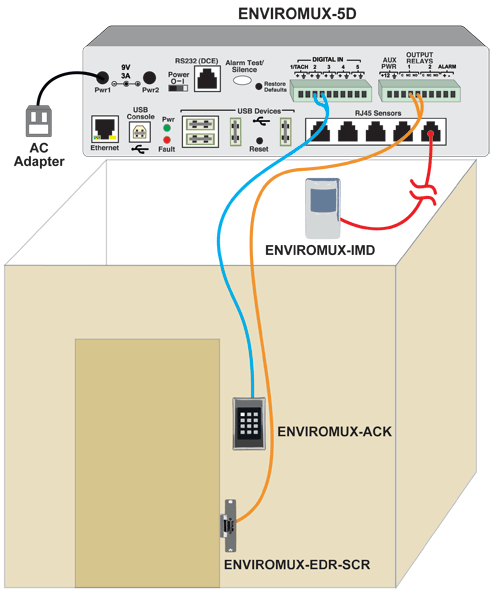|
E-5D: How to Use Smart Alerts to Inhibit Motion Sensor When Entering a Room Using a Keypad This entry explains how to create an installation where an installed motion sensor will not trigger an alarm when an operator enters and is within an enclosed room via a keypad entry, but will trigger an alarm if an intruder enters the enclosed room via other means. The set-up requires the operator to re-enter the keypad code after exiting to re-arm the security system. Instead of a regular timed delay and door strike set-up, the relay output of the keypad will be connected to the ENVIROMUX's digital input and will have to be programmed in “Toggle” or “Start/Stop” mode, which is available with all our compatible keypads. Refer to the keypad's installation manual for programming directions; it should be located within the “Programming Summary Chart” or “Programming” section. “Start/Stop” mode results in the relay contact being closed when a user code is typed, and the contact will stay closed until the code is typed again. This is key in setting up Smart Alerts so that an exception can be made while the operator is inside the enclosed area, during which the relay contact remains closed. Since the keypad's relay output is not directly linked to a door strike, additional configuration is needed to trigger a door strike entry when the correct code is entered. Two events have to be created on the ENVIROMUX unit for the single relay digital input connection. Event 1: Configure to be triggered by an open contact with a delay of a few seconds, which is programmable. This event is “normally triggered” which means that it will be constantly logged as triggered unless the contact is closed. Thus, the event will only trigger when the operator is out of the room, and not when he is inside. Event 2: Configure to be triggered by a closed contact with no delay. This event is “normally not triggered” and will only trigger when a correct code is entered into the keypad and while the operator is inside the enclosed area.
With this set up, when an operator enters the code to access the room, both events will trigger at the same time for a short period. This is due to Event 1's normally triggered status being delayed by a few seconds; while it is in delay, Event 2 will trigger simultaneously right after the code is entered on the keypad because Event 2 has no delay. Smart Alert 1 needs to be created to activate a door strike via one of the ENVIROMUX's relay outputs when Event 1 and Event 2 are triggered at the same time, which will only occur when a correct code is entered. Since the keypad is on the outside of the enclosed area, an egress function is necessary for exiting. All our compatible keypads come with an egress button input that can be configured to work with different egress functions, such as a button. The operator will enter a code on the keypad to access the enclosed area, exit via the egress function, and then re-enter the code on the keypad after he leaves to re-arm the motion sensors. To set-up deactivation of the motion sensors while the operator is within the enclosed area, regular Events and Smart Alerts need to be created for each motion sensor unit. For example, Event 3 is created for a motion sensor with a desired delay, which will trigger when motion is detected for a duration of time. The delay serves two functions: a timed delay of 6-10s is the recommended norm to prevent false alerts, and it also prevents the motion sensors from triggering when the operator first enters the enclosed area as Event 1 will clear before the both Event 1 and Event 3 can be simultaneously triggered due to the programmed delay. Configure Smart Alert 2 to activate when motion sensor Event 3 and Event 1 from above are triggered. Thus, when the operator is inside, the alarm for the motion sensors will not trigger as one (Event 1) of the two “AND” conditions set for the Smart Alert is not fulfilled. When the operator leaves and re-enters the code into the keypad, Event 1 will be triggered as the relay will now be open; if motion sensor Event 3 triggers due to an intruder as well, an alarm will be sent as both “AND” conditions are fulfilled. It is important to note that this set-up will not work unless the operator re-enters the code into the keypad after leaving via the egress function. Failing to do so will jeopardize the security of the enclosed area as the keypad's relay will remain closed (negating Event 1) and the motion sensors will not be re-armed if the operator does not enter the code again. 
|